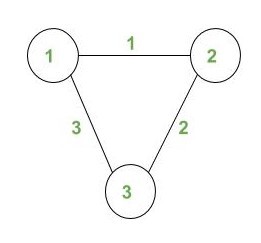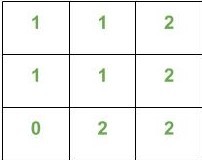给定一个加权无向图,长度 N 和成本 X。任务是计算长度为 N 的不同步行 W 的数量,使得Cost(W) = X。
我们将步行 W 的成本定义为沿步行的边权重的最大值。
节点从 1 到 n 编号。该图不包含任何多边或自环。
例子:
Input:

.
N = 4, X = 2
Output: 10
Explanation :
A walk W on the graph is a sequence of vertices (with repetitions of vertices and edges allowed) such that every adjacent pair of vertices in the sequence is an edge of the graph.
For X = 2, all possible 10 walks are listed below :
- 1 -> 2 -> 1 -> 2 -> 3
- 1 -> 2 -> 3 -> 2 -> 1
- 1 -> 2 -> 3 -> 2 -> 3
- 2 -> 1 -> 2 -> 3 -> 2
- 2 -> 3 -> 2 -> 1 -> 2
- 2 -> 3 -> 2 -> 3 -> 2
- 3 -> 2 -> 1 -> 2 -> 1
- 3 -> 2 -> 1 -> 2 -> 3
- 3 -> 2 -> 3 -> 2 -> 1
- 3 -> 2 -> 3 -> 2 -> 3
Input:

N = 4, X = 2
Output: 12
- 这个想法是预先计算no。对于所有可能成本的每个顶点的长度为 N 的步行,并将它们存储在一个二维矩阵中。让我们称这个矩阵为 B。这些值可以通过在给定的无向图上运行 DFS 来计算。
例如,

矩阵 B 的给定快照显示了存储在其中的值。这里 B(i, j) 表示没有。从顶点 i 开始的长度为 N 的步行,其成本为步行 j。
- 我们维护一个一维数组Maxedge ,其中保留长度为 N 的游走成本。当游走长度小于 N 并且有一些与边(u,v)相关的成本 X 时,我们调用相同的函数。
我们为length == N设置一个基本条件,我们更新数组B并返回调用。 - 计算矩阵 B 后,我们只需将所有具有cost = x的顶点的步行次数相加,即可计算总步行次数。
Ans += B[i][x];
Here i ranges from 1 to n where n is the no of vertices.
下面是上述方法的实现
C++
// C++ program to count the number of walks
// of length N where cost of each walk is
// equal to k
#include
using namespace std;
int G[250][250] = {0};
int Maxedge[250] = {0};
int B[250][250] = {0};
int l = 0, n, m;
// Function return total
// walk of length N
int TotalWalks(int cost)
{
int ans=0;
// Add values of all
// node with cost X
for(int i=1;i<=n;i++)
{
ans+=B[i][cost];
}
return ans;
}
// Function to precompute array B
// meantioned above
void DFS(int u, int v,int len)
{
// Base condition
if (l == len)
{
// Updating the matrix B when
// we get a walk of length N.
B[u][ Maxedge[len]]++;
return ;
}
for (int i = 1; i <= n; i++)
{
if (G[v][i] !=0)
{
// Incrementing the length
// of the walk
l++;
// Updating the cost of the walk
Maxedge[l] = max(Maxedge[l - 1],
G[v][i]);
DFS(u, i, len);
l--;
}
}
}
// Function to calculate total
// number of walks of length N
void NumberOfWalks(int cost,int len)
{
for (int i = 1; i <= n; i++)
{
// Calling the function DFS
DFS(i, i, len);
}
int ans = TotalWalks(cost);
// Print the answer
cout<< ans << endl;
}
// Driver code
int main()
{
int Cost = 2;
n = 3, m = 3;
int length = 4;
// Create a graph given in
// the above diagram
G[1][2] = 1;
G[2][1] = 1;
G[2][3] = 2;
G[3][2] = 2;
G[1][3] = 3;
G[3][1] = 3;
NumberOfWalks(Cost, length) ;
} Java
// Java program to count the number of walks
// of length N where cost of each walk is
// equal to k
import java.util.*;
class GFG{
static int [][]G = new int[250][250];
static int []Maxedge = new int[250];
static int [][]B = new int[250][250];
static int l = 0, n, m;
// Function return total
// walk of length N
static int TotalWalks(int cost)
{
int ans = 0;
// Add values of all
// node with cost X
for(int i = 1; i <= n; i++)
{
ans += B[i][cost];
}
return ans;
}
// Function to precompute array B
// meantioned above
static void DFS(int u, int v, int len)
{
// Base condition
if (l == len)
{
// Updating the matrix B when
// we get a walk of length N.
B[u][ Maxedge[len]]++;
return;
}
for (int i = 1; i <= n; i++)
{
if (G[v][i] !=0)
{
// Incrementing the length
// of the walk
l++;
// Updating the cost of the walk
Maxedge[l] = Math.max(Maxedge[l - 1],
G[v][i]);
DFS(u, i, len);
l--;
}
}
}
// Function to calculate total
// number of walks of length N
static void NumberOfWalks(int cost,int len)
{
for(int i = 1; i <= n; i++)
{
// Calling the function DFS
DFS(i, i, len);
}
int ans = TotalWalks(cost);
// Print the answer
System.out.print(ans + "\n");
}
// Driver code
public static void main(String[] args)
{
int Cost = 2;
n = 3; m = 3;
int length = 4;
// Create a graph given in
// the above diagram
G[1][2] = 1;
G[2][1] = 1;
G[2][3] = 2;
G[3][2] = 2;
G[1][3] = 3;
G[3][1] = 3;
NumberOfWalks(Cost, length);
}
}
// This code is contributed by 29AjayKumarPython3
# Python3 program to count the number of walks
# of length N where cost of each walk is
# equal to k
G = [[0 for i in range(250)]
for j in range(250)]
Maxedge = [0 for i in range(250)]
B = [[0 for i in range(250)]
for j in range(250)]
l = 0
n = 0
m = 0
# Function return total
# walk of length N
def TotalWalks(cost):
ans = 0
# Add values of all
# node with cost X
for i in range(1, n + 1):
ans += B[i][cost]
return ans
# Function to precompute array B
# meantioned above
def DFS(u, v, len):
global l
# Base condition
if (l == len):
# Updating the matrix B when
# we get a walk of length N.
B[u][ Maxedge[len]] += 1
return
for i in range(1, n + 1):
if (G[v][i] != 0):
# Incrementing the length
# of the walk
l += 1
# Updating the cost of the walk
Maxedge[l] = max(Maxedge[l - 1], G[v][i])
DFS(u, i, len)
l -= 1
# Function to calculate total
# number of walks of length N
def NumberOfWalks(cost, len):
for i in range(1, n + 1):
# Calling the function DFS
DFS(i, i, len)
ans = TotalWalks(cost)
# Print the answer
print(ans)
# Driver code
if __name__=='__main__':
Cost = 2
n = 3
m = 3
length = 4
# Create a graph given in
# the above diagram
G[1][2] = 1
G[2][1] = 1
G[2][3] = 2
G[3][2] = 2
G[1][3] = 3
G[3][1] = 3
NumberOfWalks(Cost, length)
# This code is contributed by rutvik_56C#
// C# program to count the number of walks
// of length N where cost of each walk is
// equal to k
using System;
class GFG{
static int [,]G = new int[250, 250];
static int []Maxedge = new int[250];
static int [,]B = new int[250, 250];
static int l = 0, n;
// Function return total
// walk of length N
static int TotalWalks(int cost)
{
int ans = 0;
// Add values of all
// node with cost X
for(int i = 1; i <= n; i++)
{
ans += B[i, cost];
}
return ans;
}
// Function to precompute array B
// meantioned above
static void DFS(int u, int v, int len)
{
// Base condition
if (l == len)
{
// Updating the matrix B when
// we get a walk of length N.
B[u, Maxedge[len]]++;
return;
}
for(int i = 1; i <= n; i++)
{
if (G[v, i] != 0)
{
// Incrementing the length
// of the walk
l++;
// Updating the cost of the walk
Maxedge[l] = Math.Max(Maxedge[l - 1],
G[v, i]);
DFS(u, i, len);
l--;
}
}
}
// Function to calculate total
// number of walks of length N
static void NumberOfWalks(int cost, int len)
{
for(int i = 1; i <= n; i++)
{
// Calling the function DFS
DFS(i, i, len);
}
int ans = TotalWalks(cost);
// Print the answer
Console.Write(ans + "\n");
}
// Driver code
public static void Main(String[] args)
{
int Cost = 2;
n = 3;
int length = 4;
// Create a graph given in
// the above diagram
G[1, 2] = 1;
G[2, 1] = 1;
G[2, 3] = 2;
G[3, 2] = 2;
G[1, 3] = 3;
G[3, 1] = 3;
NumberOfWalks(Cost, length);
}
}
// This code is contributed by gauravrajput1输出:
10
如果您想与行业专家一起参加直播课程,请参阅Geeks Classes Live